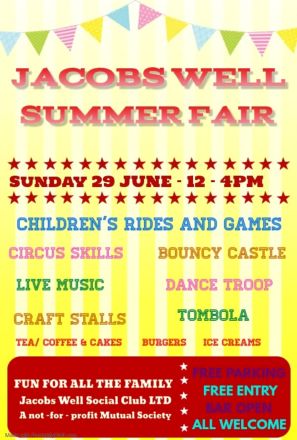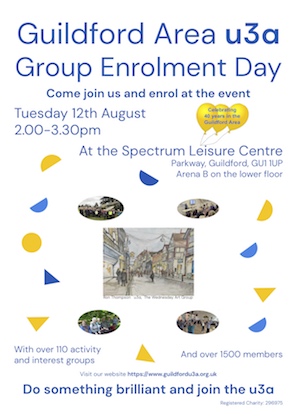- Thursday, June 26, 2025
- Stay Connected
 Abraham Lincoln
If given the truth, the people can be depended upon to meet any national crisis...
Abraham Lincoln
If given the truth, the people can be depended upon to meet any national crisis...
 Guildford news...
for Guildford people, brought to you by Guildford reporters - Guildford's own news service
Guildford news...
for Guildford people, brought to you by Guildford reporters - Guildford's own news service
Early 20th-century Guildford Artists Have Left Their Mark
Published on: 27 Feb, 2012
Updated on: 27 Feb, 2012
by David Rose
Guildford appears to have been a popular place for artists during the first couple of decades of the 20th century with their work published on picture postcards and in local guidebooks.
When I first began collecting old picture postcards I dismissed what are called ‘artist-drawn’ cards as I was only after ‘real’ photographic views of how Guildford and surrounding villages looked in days gone by.
I was a bit sceptical that artists would not have depicted a scene exactly as it looked at the time they painted it.
However, some years later, and after having thumbed past many of these ‘art’ cards at postcard and collectors’ fairs, I decided they were in fact worth collecting.
I began to notice that there were indeed several artists who were at work in Guildford in the early 1900s and a number of firms who published their work as postcards.
Later, as my collection of ephemera grew, and as I acquired old town guides along with other memorabilia, I found these publications also featured work by local artists.
The first two images seen above are well known Guildford views. The one of the Guildhall and High Street is signed ‘Victor W Burnand. A local stationer by the name of A. C. Curtis was the publisher.
A Google search of the name Burnand reveals he was a watercolour artist and illustrator, born 1868, died 1940.
Back in 2005, Christie’s sold an original of his, depicting a view of Guildford High Street from a little way up Mount Street, for £228. My postcard cost me 50p! In fact, it was the first artist-drawn card I bought. That was back in the early 1980s and I purchased it from the collectors’ shop Past Delights in Chapel Street and owned by Peter Bullen. Back then Peter himself was an avid collector of postcards and always had a good stock of Guildford cards for sale. It’s where I started off my postcard collecting habit!
A. C. Curtis also published the postcard showing the castle keep, but the artist Edwin Noble painted this.
Google tells me that Edwin Noble was also known by the name John Edwin Noble, born 1876, died 1941. He is remembered for designing posters for London Underground, in about 1916.
Whereas I have a number of other postcards of Guildford by Noble, I have just the one by Burnand.
The postcards with views of Quarry Street and Castle Arch are also by Noble. However, you can see how crude the guillotine process must have been after the cards were printed. In some cases, either the captions or signatures, printed near an outside edge, have all-but been chopped off.
I rather like Noble’s painting titled ‘St Martha’s Guildford’. This card may not qualify as a real postcard as there is no printing on the back with details of where to write the ‘communication’, the address of the receiver, or where to the stick a stamp.
His viewpoint is from Pewley Down. I love the bold watercolour brush strokes. I wonder whether he painted it at the very location or in a studio? To me, it looks like it was painted very quickly.
However, I am sure it was painted in the years just before the First World War. It was not until 1920 that the Friary Brewery purchased Pewley Down, gifting it to the town as an open space for all, in memory of those from Guildford who gave their lives during the Great War.
I also like Nobel’s depiction of St Catherine’s Chapel. In it, he painted the main road on the far right. Don’t think you’d get that view through the trees today.
His painting of Abbot’s Hospital shows the horse-drawn cabs waiting at a rank that was then outside Holy Trinity Church. How many artists today would paint the taxi rank and scene at the bottom of North Street?
It must have been a rainy day when he visited the location outside Abbot’s Hospital – note the reflections on the wet granite setts.
It is claimed that more than 2,000 paintings by the artist Alfred Robert Quinton (1853-1934) were published as postcards from 1904 onwards.
This prolific artist toured the length of Britain painting towns, villages and countryside scenes, published as postcards by J. Salmon of Sevenoaks in Kent.
Quinton certainly passed through Guildford, but I have only one of his pictures from this area in my postcard collection – it’s of the Silent Pool near Albury. In fact, I don’t like his style that much – it is a bit too ‘twee’ for me.
The picture of the fire engine racing down the High Street at night on the way to a fire, the glow of which can be seen from behind the Guildhall, has, to my knowledge never appeared on a postcard, but there are one or two mysteries attached to the image.
My version is a rather small print, dot-screened, on which I cannot make out the signature of the artist.
Bernard Parke was presented with a framed, but larger version of the same picture by the specialist vehicle manufacturer Dennis, when he was mayor in 1989.
I guess, therefore, Dennis Bros commissioned the painting, but while it shows a fire engine from the early twentieth century, the date it was painted is, as yet, unknown to me.
But was the fire depicted a real event? W. E. White & Son’s draper’s store was once in the High Street, in a building next to the White Lion Hotel, (the White Lion Walk shopping centre is now on the site of the hotel).
White’s was badly damaged by a fire on June 24, 1914. Dennis Bros’ first motorised fire engine was made in 1908 (bought by the corporation of Bradford), and within a couple of years orders for more were pouring in. I imagine that Guildford had Dennis fire engines soon after they were introduced.
However, my research states that the fire at White’s started at about 4pm. It would have been daylight at the time (being the month of June). Could there be some artistic licence on the part of the artist here?
Also, up until 1937 Guildford fire station was in North Street (the building is now the public lavatory opposite the library). Would it not have been quicker for the fire engine to turn right and go down North Street and up Market Street to the fire that appears to have been in the lower part of the High Street, as pictured?
However, the artist has painted a registration number on the vehicle: ‘DB 1317’. Can any motoring historians reading this add a date to that number?
Bernard Parke says that three letters were first added to UK number plates in 1932.
The artist A Nelson Mapple also painted scenes of Guildford that were issued as postcards. They appear to date from the 1910s and were published by Biddle Ltd of Guildford.
At the time of writing, I have not found out anything about the artist, but Biddles was once a well known local printers, now based in Kings Lynn, Norfolk.
Leonard Biddle opened a stationery shop in Martyr Road, Guildford, in 1885. By the time of the First World War, the firm employed 30 staff in a purpose-built print factory erected on the site.
In the 1920s, Biddles became one of the first printers in the UK to use the then latest typesetting machinery. In 1935 the printing works was extended to five floors, which during the Second World War made air filters for British aircraft industry.
Biddles’ print works was next to the Surrey Advertiser print room and offices. Both were demolished some years ago and the site has now been redeveloped with flats and apartments. A reminder of the trade that once went on there is remembered by the name of the new development – Printing House Square.
These Biddles postcards were printed on slightly embossed card that resembles canvas. I can’t decide on the medium Mapple used. I don’t think they are watercolours, maybe a reader can help out.
However, on the back of each card details are printed of the scene that is depicted. For example, the wording on the reverse of the card that shows St Catherine’s Hill (that I think has an Art Nouveau feel to the composition), reads: ‘St Catherine’s Hill, Guildford – surmounted by the ruined Chapel of the Saint – lies between the Portsmouth Road and the River Wey on the south side of Guildford. Leave the High Street by Quarry Street and in Shalford Road cross the rustic bridge, and follow the towpath to St Catherine’s hill; return by the ferry and follow the old Pilgrims’ Way across Shalford Park and through the Chantry Woods.’
I have six of these Biddles postcards in my collection. Three are printed with the words ‘SERIES I’, and three are printed ‘SERIES II’. Postcard series usually included six in a set. Is there more out there waiting to be found?
I have some town guidebooks in my collection, one in particular printed by Biddles and featuring the work of artist Florence Biddle. I believe she may have been a daughter of the firm’s founder.
In the guidebook titled ‘Old-World Guildford’, published by the town’s chamber of trade in the 1920s and printed by Biddles, a selection of Florence Biddle’s work appears. (Biddles also issued coloured prints of her work – I have a couple of those as well). However, in the guide she also writes a chapter titled ‘The Artist in Guildford’.
An excerpt of her words sums up this story rather well: ‘The first sensation of a painter newly arriving in Guildford must be that of bewilderment. He finds so many and such varied pictures that it is difficult for him to know where to begin his work.
‘To take, first, the purely landscape subjects; there are many worthy of the brush of a Turner or Constable. A walk to Pewley Hill will give a range of views from which a selection may be made.
‘The artist should stand on the Town Bridge at the point at which the tower of Trinity Church may be seen above the buildings at the right-hand side. The upward winding of the street is probably unrivalled in line.
‘Or if simpler subjects are sought, there is the Castle Keep from some corner of the Castle Grounds; nearby is the old Castle Arch. From South Hill may be seen Tuns Gate with the turret of the Town Hall rising above it. There are many pictures of odd corners of the town, as yet untouched by artists, but well worthy of their attention’.

























Recent Comments